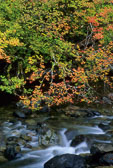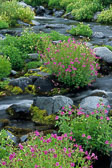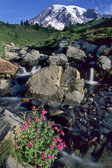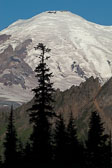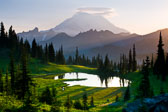Mt. Rainier
 Technically more of a central Washington location, I am nonetheless including some of my favorite sites in Mt. Rainier National Park and the surrounding area. If you want some spectacular mountain landscape images, Mt. Rainier is the place to go.
Technically more of a central Washington location, I am nonetheless including some of my favorite sites in Mt. Rainier National Park and the surrounding area. If you want some spectacular mountain landscape images, Mt. Rainier is the place to go.
Early to mid-August is a great time to be at Rainier, the wildflowers are usually at their peak and the weather is usually…let’s just say you can expect just about anything. But for the most part, August is the driest month of the year and you stand the least chance of getting rained on. But if you do, never fear. A great feature of Mt. Rainier National Park is that there are things to photograph no matter what the weather is like. On sunny days, photograph mountain landscapes. On overcast or rainy days, head for the streams and forests or work on flower portraits.
Mt. Rainier is a great fall color destination and nearly all the sites mentioned below can be revisited in late September into October. Bright red Dwarf Huckleberry leaves, orange Mountain Ash, along with willow, and maple trees provide some brilliant autumn colors.
Winter is also a good time to visit. Unless you’re a cross country skier or you snowshoe, you’re pretty much stuck with the road to Paradise and the Paradise area, which isn’t bad at all. The Park service tries to keep the road open all year round but this of course is subject to weather and avalanche conditions. If you plan on making a winter visit be sure to call 360-569-2211 to check on road status.
Driving anywhere in MRNP can take a while so allow plenty of time to get to sunrise and sunset locations.
The main roads to Mt. Rainier are State Route 706 to access the southwest side of the park, and Hwy 12 and State Route 410 to access the east side.
Paradise
 The Paradise area is the most popular and one of the best places to go for photography. Get there early as the parking lot can fill by noon, especially on a weekend.
There's a whole network of trails at Paradise and they all can be good. Virtually all of them head uphill. From the parking area you have several options and they’re all worth exploring. One favorite spot of mine is on the Skyline Trail where it crosses Edith Creek at Myrtle Falls. This is about a half mile walk from the parking lot. There is short, gentle uphill stretch toward the end but for the most part, it’s a flat trail. You’ll find a great view of Rainier with flowers and stream as foreground. Myrtle Falls is just below you and a side trail leads to a viewpoint. This area is probably best mid-morning before the light gets too harsh, yet late enough to allow light into the falls.
The Paradise area is the most popular and one of the best places to go for photography. Get there early as the parking lot can fill by noon, especially on a weekend.
There's a whole network of trails at Paradise and they all can be good. Virtually all of them head uphill. From the parking area you have several options and they’re all worth exploring. One favorite spot of mine is on the Skyline Trail where it crosses Edith Creek at Myrtle Falls. This is about a half mile walk from the parking lot. There is short, gentle uphill stretch toward the end but for the most part, it’s a flat trail. You’ll find a great view of Rainier with flowers and stream as foreground. Myrtle Falls is just below you and a side trail leads to a viewpoint. This area is probably best mid-morning before the light gets too harsh, yet late enough to allow light into the falls.
One spot I particularly like is just past the main parking area where the road becomes a one-way. This road follows the valley and connects back with the main road below. After you leave the big parking area at Paradise, you’ll start down hill. Look for a big wide turn in the road; there's a pretty good sized parking area. The Paradise River (it’s really a small stream) crosses here and the Fourth Crossing Trail leads up along the river. You'll find pink Lewis Monkey Flowers and stream shots all over the place. You can shoot right from the bridge but for more, follow the trail. After about ¼ mile, Fourth Crossing Trail intersects with the Skyline Trail. Turn right and keep following this trail. The river is running to your left and soon you’ll come to a stretch where the river, which is a little wider than along the Fourth Crossing Trail, is lined with wildflowers. I’ve spent hours along here.
 The trail continues up hill and comes to an intersection. Turn right onto the Lakes Trail for areas of wildflowers and views of Rainier, or turn left and continue on the Skyline Trail towards Sluiskin Falls (0.4 mile) and more mountain views.
If you’re here for sunrise, after you’re done photographing treat yourself to breakfast at the Paradise Lodge. They’ve always had the most wonder buffet breakfast with fruits, pancakes, waffles, all kinds of breakfast meats, pastries, eggs, potatoes and more. So once you’re done shooting in the morning, go grab breakfast with a view.
From the Nisqually entrance it’s about 18 miles to Paradise. Give yourself at least 45 minutes for the drive.
The trail continues up hill and comes to an intersection. Turn right onto the Lakes Trail for areas of wildflowers and views of Rainier, or turn left and continue on the Skyline Trail towards Sluiskin Falls (0.4 mile) and more mountain views.
If you’re here for sunrise, after you’re done photographing treat yourself to breakfast at the Paradise Lodge. They’ve always had the most wonder buffet breakfast with fruits, pancakes, waffles, all kinds of breakfast meats, pastries, eggs, potatoes and more. So once you’re done shooting in the morning, go grab breakfast with a view.
From the Nisqually entrance it’s about 18 miles to Paradise. Give yourself at least 45 minutes for the drive.Narada Falls
Narada Falls, about 15.5 miles from the Nisqually entrance, is one of the most visited falls in the park. It’s not that easy to photograph and I suggest using a mid range telephoto (80-200) and trying for pieces in addition to photographing the whole thing with a wide angle lens. A trail leads down to a viewpoint. On a sunny morning, rainbows form in the mist in front of the falls. Try using a polarizer to enhance the rainbow (or to get rid of it if you don’t like those pesky rainbows). Be ready to cover your lens if the mist blows your way.
Reflection Lakes
 Reflection Lakes is the classic location for mountain reflection shots. It’s also one of the best places in the park for sunrise. Get here well before the sun comes up to find a vantage point. Better yet, come out the day before and scout along the shoreline to find your shot. There are actually two lakes here and good photographs can be made from both.
Reflection Lakes is the classic location for mountain reflection shots. It’s also one of the best places in the park for sunrise. Get here well before the sun comes up to find a vantage point. Better yet, come out the day before and scout along the shoreline to find your shot. There are actually two lakes here and good photographs can be made from both.
Most of the shoreline is a restoration zone and signs are everywhere asking you to not walk in the meadows. There are, however, a few places where the trail along the larger lake touches along the shore.
One popular spot to set up is right on the road at the east end of the larger of the two lakes. From here you can get a real easy mirror image shot of the mountain in the lake. I prefer to get closer to the water and use floating grasses, or flowers, or just about anything as a foreground. Once you get that mirror image shot, start looking for other possibilities.
 Though the shot of the mountain at sunrise is hard to beat, there are shots to be made before sunrise. From about the middle to the west end of the lake, if you look to the east you can get photographs of tree silhouettes and their reflection surrounded by the brilliant colors of sunrise. If you're lucky, one of your mornings here will be foggy. Did I mention you should plan on coming here more than once? Start with this shot and then move to where you scouted your mountain sunrise shot.
Though the shot of the mountain at sunrise is hard to beat, there are shots to be made before sunrise. From about the middle to the west end of the lake, if you look to the east you can get photographs of tree silhouettes and their reflection surrounded by the brilliant colors of sunrise. If you're lucky, one of your mornings here will be foggy. Did I mention you should plan on coming here more than once? Start with this shot and then move to where you scouted your mountain sunrise shot.
From the Nisqually entrance, it’s about 18 miles to Reflection Lakes. Give yourself at least a half hour to drive the road. Time your departure to arrive well before sunrise.
Paradise Falls
 On your way to Reflection Lakes from the Nisqually entrance, right at the turn off to Paradise, is a bridge crossing the Paradise River. Paradise Falls is just below and is easy to get to. Park here and follow the trail to the falls viewpoint. This is best done on an overcast day.
On your way to Reflection Lakes from the Nisqually entrance, right at the turn off to Paradise, is a bridge crossing the Paradise River. Paradise Falls is just below and is easy to get to. Park here and follow the trail to the falls viewpoint. This is best done on an overcast day.
Right below the bridge is a large granite outcropping. From here you can photograph details in the stream. Photograph the water flowing over the granite base at slow shutter speeds.
Bench Lake Trail
You only need to hike the Bench Lake Trail a short distance to get more stunning views of the mountain. About ¼ mile from the trail head you’ll emerge into a relatively flat “bench” area. In the summer look for Bear Grass and other wildflowers to use as foreground. In the fall, Mountain Ash and Dwarf Huckleberry provide brilliant color. Keep following the trail to Bench Lake (about ½ mile), and beyond that, Snow Lake (about 1 mile).
The Bench Lake trail parking area is approximately 1.5 miles east of Reflection Lakes.
Box Canyon
 Box Canyon is a good place to visit midday. It’s about 24.5 miles from the Nisqually entrance and about 10 miles from the Stevens Canyon Entrance on the east side of the park. The trail follows a deep canyon a short distance to a river crossing. From this area you’ll have good views of the mountain. A split-rail fence makes a nice foreground object here.
Box Canyon is a good place to visit midday. It’s about 24.5 miles from the Nisqually entrance and about 10 miles from the Stevens Canyon Entrance on the east side of the park. The trail follows a deep canyon a short distance to a river crossing. From this area you’ll have good views of the mountain. A split-rail fence makes a nice foreground object here.
Nickel Creek
Nickel Creek is another half mile east of Box Canyon. A trail leads down hill, on the south side of the road, along the creek. The patterns and striations in the rock here are fun to photograph. Try filling the frame with rolling curves.
Sunrise
 Sunrise can be good for both sunrise and sunset. Try the trail to Frozen Lake early in the morning for some good early light shots of the mountain. There are also plenty of wildflowers in the Sunrise area, though you may need to venture out onto the trails to find the best displays. I’ve often had good luck by following the trail just south of the visitor center. Also try the trails that climb up the hill north of the visitor center.
Sunrise can be good for both sunrise and sunset. Try the trail to Frozen Lake early in the morning for some good early light shots of the mountain. There are also plenty of wildflowers in the Sunrise area, though you may need to venture out onto the trails to find the best displays. I’ve often had good luck by following the trail just south of the visitor center. Also try the trails that climb up the hill north of the visitor center.
Be sure to check out some of the viewpoints on the road to Sunrise as well, especially the last switchback) before you get to Sunrise itself. This spot is about 12.5 miles from SR 410.
Tipsoo Lake
Upper Tipsoo Lake is another good spot to photograph Rainier reflections. It’s also a great sunrise or sunset spot. Upper Tipsoo is right next to the road. Follow the trail to the far side of the lake for reflection shots of Mt. Rainier. Climb up the hill behind the lake for a more expansive view, which is one of my all time favorite views of The Mountain. This site is accessible only in the summer and early fall. By the end of October or early November, Chinook Pass, and SR 410 are usually closed for the winter.
Directions: If you’re on the east side of the park, from Packwood drive north on SR 12 to SR123. Follow SR 123 past the Stevens Canyon entrance (don’t enter the park). About 11 miles past the Stevens Canyon entrance turn right (east) on SR 410 (to Chinook Pass) and drive about 3 miles to road side parking. Cross the road to the trail. Allow an hour from Packwood.
If you’re on the west side of the park set your alarm clock for an obscenely early hour (especially in the summer) and drive completely through the park to the Stevens Canyon Entrance. Turn north on SR 123 and follow the directions as above. Allow two hours.
Grove of the Patriarchs
 Grove of the Patriarchs is on the southeast side of the park just inside the Stevens Canyon Entrance. A trail leads from the parking area to a suspension bridge. Cross the bridge to the Trail of the Patriarchs. The grove is on an island in the middle of the Ohanapecosh River, some of the trees nearly 1000 years old.
Grove of the Patriarchs is on the southeast side of the park just inside the Stevens Canyon Entrance. A trail leads from the parking area to a suspension bridge. Cross the bridge to the Trail of the Patriarchs. The grove is on an island in the middle of the Ohanapecosh River, some of the trees nearly 1000 years old.
Forest photography requires that you try to render order out of the chaos. One method is to pick a short telephoto lens, like an 80-200 zoom, and pull out pieces of the forest. Another way is to use a wide angle lens and find a strong foreground with which to fill most of the frame. Look for stands of trees that are relatively in the open and use wide to short telephoto lenses to photograph just the trunks. Make it a study in lines. And be sure you have your polarizer on and try to avoid sunny days.
Directions: Drive ¼ mile past the Stevens Canyon entrance just beyond the Ohanapecosh River Bridge. The bridge is another good place from which to photograph.
Skate Creek Road
 Skate Creek Road is not actually in the park but it’s a faster means of getting from the Nisqually entrance to Packwood on the southeast side of the park. Along the way you’ll be following Skate Creek, which is good to photograph any time of the year but is especially nice in the autumn.
The Skate Creek Road intersects SR 12 in Packwood; in fact it’s the main intersection in Packwood. Fall color is best near the Packwood end of the road. Skate Creek Road becomes Forest Service Road 52 and intersect SR 706 about 2.4 miles east of Ashford and 3.5 miles west of the park entrance.
Skate Creek Road is not actually in the park but it’s a faster means of getting from the Nisqually entrance to Packwood on the southeast side of the park. Along the way you’ll be following Skate Creek, which is good to photograph any time of the year but is especially nice in the autumn.
The Skate Creek Road intersects SR 12 in Packwood; in fact it’s the main intersection in Packwood. Fall color is best near the Packwood end of the road. Skate Creek Road becomes Forest Service Road 52 and intersect SR 706 about 2.4 miles east of Ashford and 3.5 miles west of the park entrance.
Hitting the trails
Mt. Rainier National Park has numerous trails leading to spectacular sites. I suggest getting a detailed guide to the trails of Mt. Rainier before trying any of these. Here are a couple of suggestions:
Spray Park
Take SR 165 (Mowich Lake Road) from the city of Carbonado to Lake Mowich. From there follow the trail to Spray Park and Seattle Park for wildflower filled vistas of the mountain. It’s about 3 miles with a 1300 foot elevation gain to Spray Park. Along the way you’ll pass the impressive Spray Falls.
Indian Henry’s
 Indian Henry’s is another impressive place with fields of wildflowers and views of Mt. Rainier. From the Nisqually entrance drive about 3.3 miles to the Kautz Creek trailhead. The trail leads to Indian Henry’s and Mirror Lake. It’s about 6 miles to Indian Henry’s with a 3000 foot elevation gain and another half mile or so to Mirror Lake. Good for flowers mid-July through early August.
Indian Henry’s is another impressive place with fields of wildflowers and views of Mt. Rainier. From the Nisqually entrance drive about 3.3 miles to the Kautz Creek trailhead. The trail leads to Indian Henry’s and Mirror Lake. It’s about 6 miles to Indian Henry’s with a 3000 foot elevation gain and another half mile or so to Mirror Lake. Good for flowers mid-July through early August.
Places to stay:
Lodging can be found in Ashford, just outside the Nisqually entrance, and Packwood, on the southeast side of the park. There are also lodges and several campgrounds in the park.
Other resources
There are a couple of pretty good Mt. Rainier Photo Rovers Maps available from Tom Haseltine. These maps were compiled by local photographers and contain their favorite sites. The map includes sample images from most of the sites. Well worth the $5.95.




